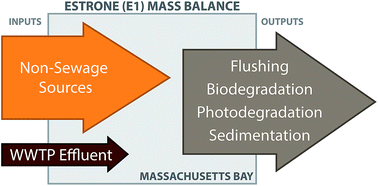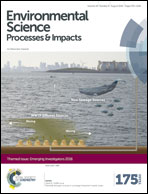Steroidal estrogen sources in a sewage-impacted coastal ocean†
Abstract
Estrogens are known to be potent endocrine disrupting chemicals that are commonly found in wastewater effluents at ng L−1 levels. Yet, we know very little about the distribution and fate of estrogens in coastal oceans that receive wastewater inputs. This study measured a wide range of steroidal estrogens in sewage-impacted seawater using ultra high performance liquid chromatography (UHPLC) tandem mass spectrometry (MS/MS) together with the method of standard addition. In Massachusetts Bay, we find conjugated, free, and halogenated estrogens at concentrations that are consistent with dilution at sites close to the sewage source. At a site 6 miles down current of the sewage source, we observe estrone (E1) concentrations (520 ± 180 pg L−1) that are nearly double the nearfield concentrations (320 ± 60 pg L−1) despite 9-fold dilution of carbamazepine, which was used as a conservative sewage tracer. Our results suggest that background E1 concentrations in Massachusetts Bay (∼270 ± 50 pg L−1) are derived largely from sources unrelated to wastewater effluent such as marine vertebrates.

- This article is part of the themed collection: Emerging Investigators 2016

 Please wait while we load your content...
Please wait while we load your content...